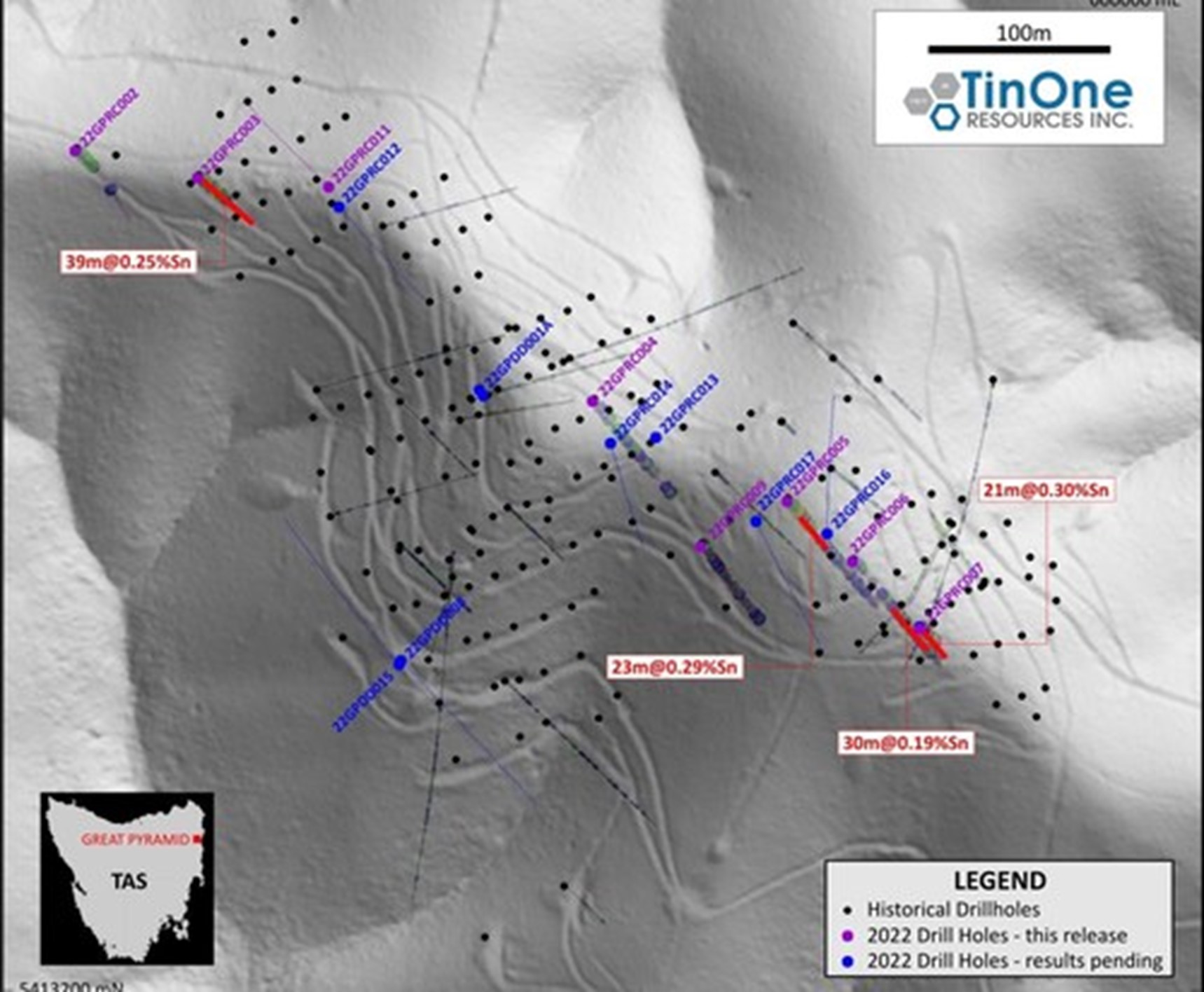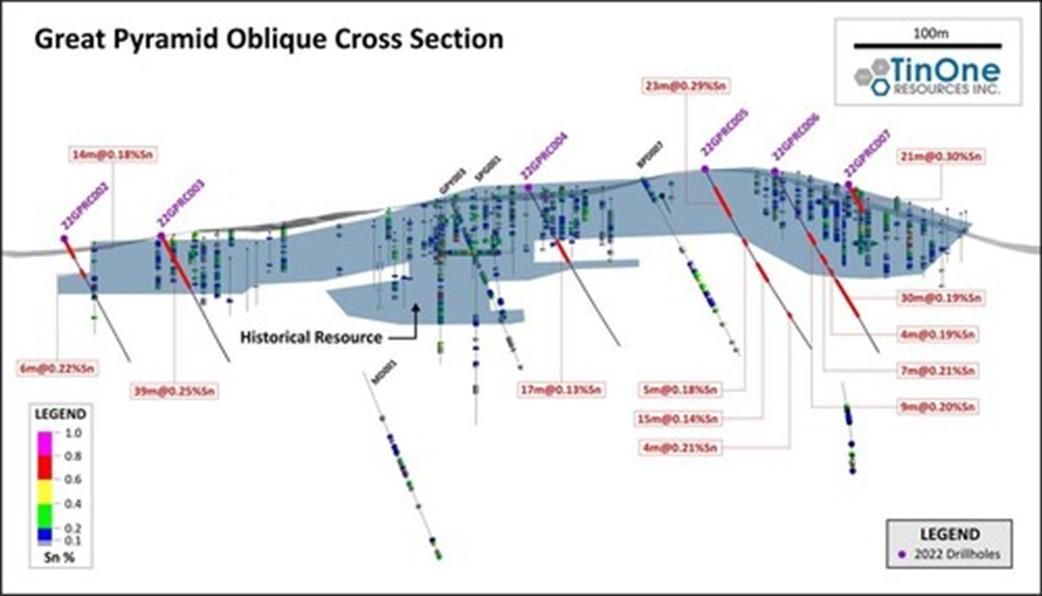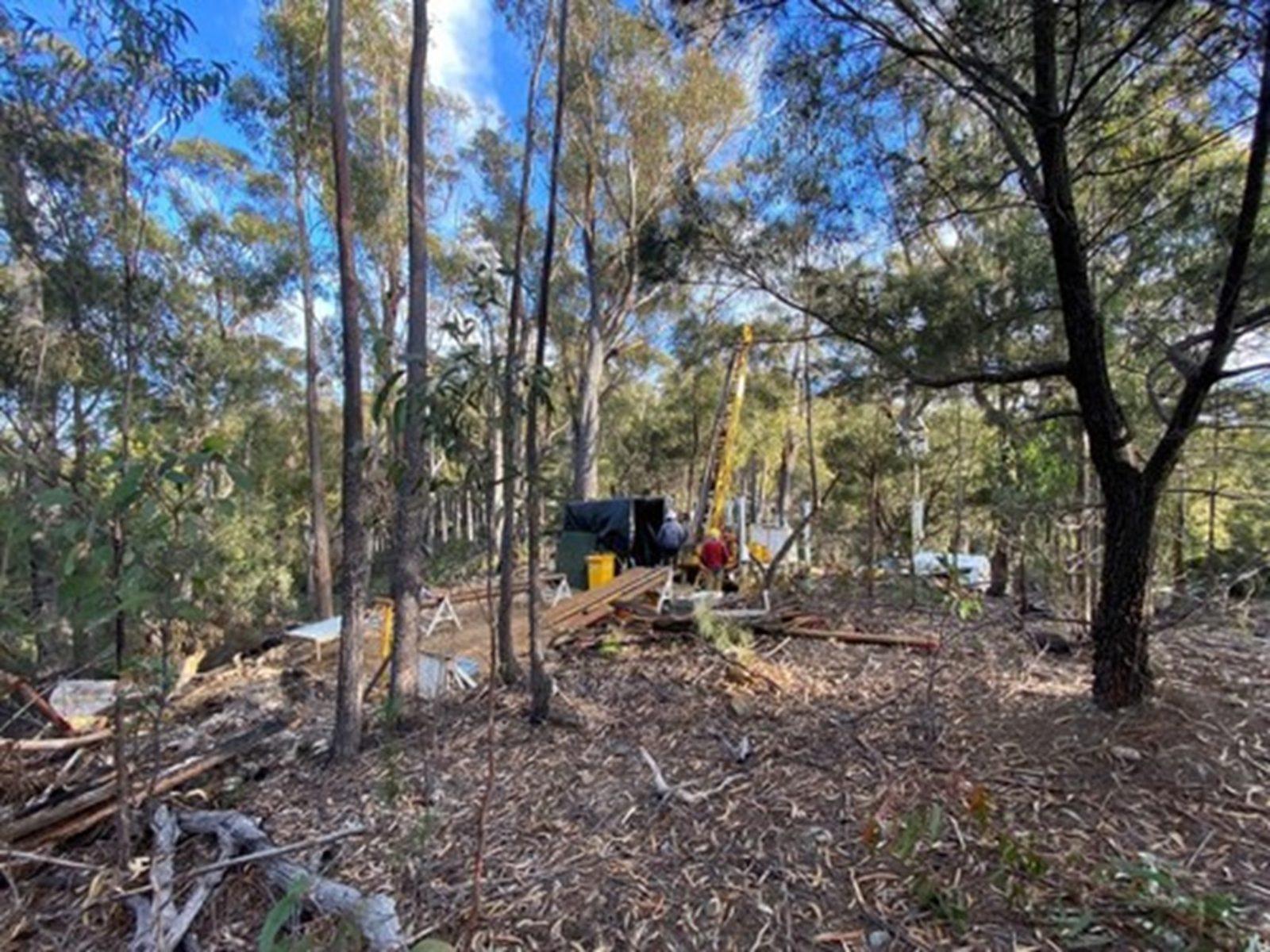
TinOne Reports First Results from Drilling its Great Pyramid Project, Tasmania, Australia

TinOne Resources Inc. (TSX-V: TORC) is pleased to provide the first drill results from its Great Pyramid Tin project located in the tier one mining jurisdiction of Tasmania, Australia.
Highlights:
- All holes returned Tin-bearing intersections and provide support for historical drill data
- Mineralised zones shown to extend beneath historical resource
- Highly encouraging intersections include:
- 22GPRC003 returned 0.25% Sn over 39 metres
- 22GPRC005 returned 0.29% Sn over 23 metres
- 22GPRC006 returned 0.19% Sn over 30 metres
- 22GPRC007 returned 0.30% Sn over 21 metres
Results have been received for 764 metres of the Company’s ongoing 5,500 metre drilling program at its Great Pyramid project in Tasmania, Australia. These results represent complete results for seven Reverse Circulation drill holes and partial results for one additional RC hole. Assays are being fast tracked and average laboratory turnaround to-date has been 23 days.
Drilling commenced at the Great Pyramid project on April 27, 2022, with three drill rigs currently operating on site, including two Diamond (DD) rigs and one RC rig. The initial program consists of approximately 5,500 metres and has several objectives:
- Test the depth and lateral extensions of the historical resource;
- Test a large-scale IP chargeability anomaly adjacent to the historic resource; and,
- Obtain grade and continuity data utilising modern drill and analytical techniques, within the area of the historic resource.
“We are extremely pleased to report our first results from our Great Pyramid tin project so quickly after listing,” commented Chris Donaldson, Executive Chairman. “The results have demonstrated robust grade continuity within the historical resource at grades equal to or above historical grades. In addition, the results provide further confidence that mineralisation extends below the historical resource. Ongoing work will fill gaps in the data coverage, particularly at depth, and allow us to develop our grade distribution model and build our geological interpretation to integrate with the extensive historical database.”
Results reported here are predominantly from the upper portions of the project area within the historical resource1 area and demonstrate consistent tin grades over substantial thicknesses (Table 1). Mineralised intersections were also encountered beneath the historical resource1 area (Table 1, Figure 3) and demonstrate that in certain areas mineralisation extends to depth below the historical resource1 area, consistent with historical drill data2.
In addition to the RC drill results reported here, an additional 1,102 metres of diamond drilling has been completed within, lateral to and beneath the historical resource area. Drill core processing is underway with an initial 209 metres of core despatched to the laboratory. To-date these diamond holes have intersected alteration and mineralisation over variable thicknesses up to 120m beneath the historical resource area (Figures 4, 5, 6).
Table 1: Great Pyramid RC drill results. More significant results are shown in bold.
| Hole | Intersection Width (m) |
From (m) |
Sn% | Comments |
| 22GPRC002 | 14 | 3 | 0.18 | On margin of historical resource area. |
| 22GPRC002 | 6 | 24 | 0.22 | On margin of historical resource area. |
| 22GPRC002 | 3 | 56 | 0.15 | On margin of historical resource area. |
| 22GPRC003 | 39 | 3 | 0.25 | Within historical resource area. |
| 22GPRC003 | 7 | 32 | 0.19 | Within historical resource area. Diamond tail to be completed. |
| 22GPRC004 | 17 | 41 | 0.13 | Within and beneath historical resource area. |
| 22GPRC004 | 5 | 62 | 0.14 | Beneath historical resource area. |
| 22GPRC004 | 3 | 87 | 0.22 | Beneath historical resource area. |
| 22GPRC004 | 3 | 124 | 0.16 | Beneath historical resource area to end of hole. Diamond tail to be completed. |
| 22GPRC005 | 3 | 8 | 0.30 | Within historical resource area. |
| 22GPRC005 | 23 | 15 | 0.29 | Within historical resource area. |
| 22GPRC005 | 5 | 54 | 0.18 | Beneath historical resource area. |
| 22GPRC005 | 15 | 72 | 0.14 | Beneath historical resource area. |
| 22GGRC005 | 4 | 112 | 0.21 | Beneath historical resource area. Diamond tail to be completed. |
| 22GPRC006 | 9 | 48 | 0.20 | Beneath historical resource area. |
| 22GPRC006 | 7 | 65 | 0.21 | Beneath historical resource area. |
| 22GPRC006 | 4 | 76 | 0.19 | Beneath historical resource area. |
| 22GPRC006 | 30 | 84 | 0.19 | Beneath historical resource area. Diamond tail to be completed. |
| 22GPRC007 | 21 | 2 | 0.30 | Within historical resource area. To end of hole. Hole intersected historic underground working. To be redrilled. |
| 22GPRC009 | 3 | 102 | 0.19 | Beneath historical resource area. Redrilled with diamond tail to be completed. |
| 22GPRC011 | 5 | 1 | 0.41 | Partial results only, remaining results pending. |
| NOTES: All intersections are calculated with a cut-off grade of 0.1% Sn with maximum consecutive internal waste of 3 metres. | ||||
| All intersections are downhole widths, true widths are uncertain. | ||||
| TinOne drill hole numbering is in the form 22GPRCXXX for RC holes and 22GPRDDXXX for diamond holes with numbering allocated in sequence. | ||||
| Analytical results have been received for holes 22GPRC002, 003, 004, 005, 006, 007, 009 and partial 011. | ||||
| Diamond holes completed to-date and with assays pending are 22GPDD001, 22GPDD001A (redrill of 22GPDD001 which was abandoned at 42.1m), 22GPDD008, 22GPDD10 and 22GPDD015. | ||||
About the Great Pyramid Tin Project
Geological Setting
The Great Pyramid deposit is located around a topographical feature known as Pyramid Hill and is hosted by Silurian to Devonian Mathinna Supergroup sandstones. The mineralization is formed by closely spaced sheeted northeast trending, cassiterite (SnO₂) bearing veins associated with silicification and sericite-pyrite alteration. The deposit style and regional comparisons suggests that a tin-fertile granite exists at depth below the deposit, however this has not been encountered in drilling and the deposit is open at depth. Geological interpretation indicates that certain sedimentary units within the folded Mathinna Supergroup sediments are more favourable hosts and diamond drilling being undertaken by the Company during the current campaign, combined with numerical modelling, will assist in developing a deeper understanding of controls on grade for follow up drilling.
The deposit is currently known over a strike length of more than 500 metres with an average width of approximately 150 metres. The depth extent of the deposit is unknown with only nine historical drill holes greater than 150 metres deep. These rare deeper holes encountered encouraging tin mineralization to depths of approximately 300 metres below surface2.
Historic Resources and Drill Data1
The previous owners of the Great Pyramid project estimated an Inferred Resource reported under the JORC 2012 guidelines. This resource contains approximately 10,000 tonnes of tin at a grade of 0.2% tin (Table 2). The estimation utilised close spaced historic percussion (~85%) and lesser diamond drill holes with drill spacing in the estimation area typically 15 x 30m and locally closer. Although the resource is defined by close spaced drilling, the resource was classified by the previous owners as Inferred due to the historic nature of the data. The estimate was reported in the independent geological report prepared by Mining One Pty Ltd for TNT Mines Ltd, dated June 26, 2017.
Table 2: Great Pyramid Historical Inferred Mineral Resource1
| Great Pyramid Inferred Mineral Resource – JORC 2012 | |||
| Sn% CUT OFF | TONNES (Mt) | GRADE (Sn%) | CONTAINED TIN (kt) |
| 0.1 | 5.2 | 0.2 | 10.4 |
The Inferred Resource was estimated using Multiple Indicator Kriging method of 1.5 metre down-hole composites within a mineralized domain interpreted from tin grade. The estimate is restricted to the area of close spaced drilling and 90% of the resource occurs within 40 metres of surface. Although the limited deeper drilling has encountered mineralized material this was not included in the resource. Additional drilling utilising modern drill techniques, analytical techniques and QA/QC will be required to re-estimate the resource and report under NI 43-101.
1The reader is cautioned that the above referenced “Inferred Resource” estimates are considered historical in nature and are based on prior data and reports prepared by previous property owners. A qualified person has not done sufficient work to classify the historical estimate as current mineral resources or mineral reserves and TinOne is not treating the historical estimate as current mineral resources or mineral reserves. Significant data compilation, re-drilling, re-sampling and data verification may be required by a qualified person before the historical estimate on the Great Pyramid property can be classified as a current resource. There can be no assurance that any of the historical mineral resources, in whole or in part, will ever become economically viable. In addition, mineral resources are not mineral reserves and do not have demonstrated economic viability. Even if classified as a current resource, there is no certainty as to whether further exploration will result in any inferred mineral resources being upgraded to an indicated or measured mineral resource category.
2Data regarding historical drilling is sourced from Mineral Resources Tasmania online database (MRTMap). In addition, data for 18GPD001 has been sourced from a public announcement by previous owners TNT Mines, November 15, 2018. However, the “historical drill data” are considered historical in nature and are based on prior data and reports prepared by previous property owners. A qualified person has not done sufficient work to classify the historical data as current and TinOne is not treating the historical data as current. There can be no assurance that any of the historical drill data is representative.
Quality Assurance / Quality Control
Drill core and RC samples were shipped to ALS Limited in Brisbane, Australia for sample preparation and for analysis. The ALS, Brisbane facilities are ISO 9001 and ISO/IEC 17025 certified. Tin and tungsten are analysed by ICP-MS following lithium borate fusion (ALS method ME-MS85), overlimit results are reanalysed by XRF (ALS method XRF15b). Forty-eight element multi-element analyses are conducted by ICP-MS with a four-acid digestion (ALS method ME-MS61).
Control samples comprising certified reference samples, duplicates and blank samples were systematically inserted into the sample stream and analyzed as part of the Company’s quality assurance / quality control protocol.
About TinOne
TinOne is a TSX Venture Exchange listed Canadian public company with a high-quality portfolio of tin projects in the Tier 1 mining jurisdictions of Tasmania and New South Wales, Australia. The Company is focussed on advancing its highly prospective portfolio while also evaluating additional tin opportunities. TinOne is supported by Inventa Capital Corp.
Qualified Person
The Company’s disclosure of technical or scientific information in this press release has been reviewed and approved by Dr. Stuart Smith., Technical Adviser for TinOne. Dr. Smith is a Qualified Person as defined under the terms of National Instrument 43-101.

Figure 1: Location of the Company’s projects in the mining friendly jurisdiction of Tasmania (CNW Group/TinOne Resources Corp.)

Figure 2: Great Pyramid drilling plan. Holes reported in this release are labelled. Historic drill collars and traces (for angled holes) are also shown. (CNW Group/TinOne Resources Corp.)

Figure 3: Great Pyramid oblique cross section showing holes reported in this release and historic drill holes. Vertical cross section, 25m window. (CNW Group/TinOne Resources Corp.)

Figure 4: Great Pyramid diamond core (22GPDD008, 166.5m). Bedded sandstone with multiphase quartz-sulphide veins (sulphides dominated by arsenopyrite-pyrrhotite-chalcopyrite) associated with chlorite and sericite alteration. Diamond drill hole beneath historic resource area, assay results pending. (CNW Group/TinOne Resources Corp.)

Figure 5: Great Pyramid diamond core (22GPDD008, 123m). Interbedded sandstone and siltstone with multiphase quartz-sulphide veins (sulphides dominated by arsenopyrite-pyrrhotite-pyrite) associated with biotite, chlorite and sericite alteration. Diamond drill hole beneath historic resource area, assay results pending. (CNW Group/TinOne Resources Corp.)

Figure 6: Great Pyramid diamond core (22GPDD001A, 123.1m). Strong chlorite-quartz alteration with abundant pyrrhotite-chalcopyrite-pyrite-magnetite veins and breccia. Diamond drill hole beneath historic resource area, assay results pending. (CNW Group/TinOne Resources Corp.)

Figure 7: RC drilling at Great Pyramid (CNW Group/TinOne Resources Corp.)

Figure 8: Diamond drilling at Great Pyramid (CNW Group/TinOne Resources Corp.)
MORE or "UNCATEGORIZED"
Doubleview Extends High-Grade Domains at Hat: H099 Returns 438m of 0.40% CuEq Including 52m of 1.02% CuEq, Expanding Mineralization Envelope Around Conceptual Pit Vertically and Laterally
Doubleview Gold Corp. (TSX-V: DBG) (OTCQB: DBLVF) (FSE: 1D4) is pleased to announce assay results f... READ MORE
Cosa Closes Upsized C$7.5 Million Private Placement
Cosa Resources Corp. (TSX-V: COSA) (OTCQB: COSAF) (FSE: SSKU) is pleased to announce that it ... READ MORE
Americas Gold and Silver Closes US$132.25 Million Bought Deal Financing
Americas Gold and Silver Corporation (TSX: USA) (NYSE American: USAS) is pleased to report that it h... READ MORE
1911 Gold Closes C$23 Million "Best Efforts" Life Offering & Private Placement and Provides Corporate Updates
1911 Gold Corporation (TSX-V: AUMB) (FRA: 2KY) is pleased to announce that it has completed its prev... READ MORE
Endeavour Silver Completes US$350 Million Offering of Convertible Senior Notes
Endeavour Silver Corp. (NYSE: EXK) (TSX: EDR) announced today the closing of its previously announce... READ MORE












